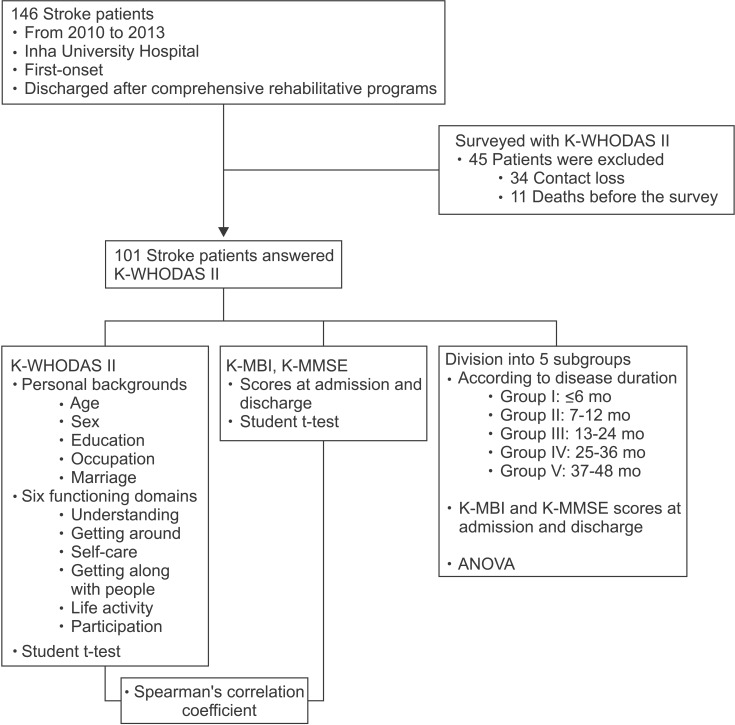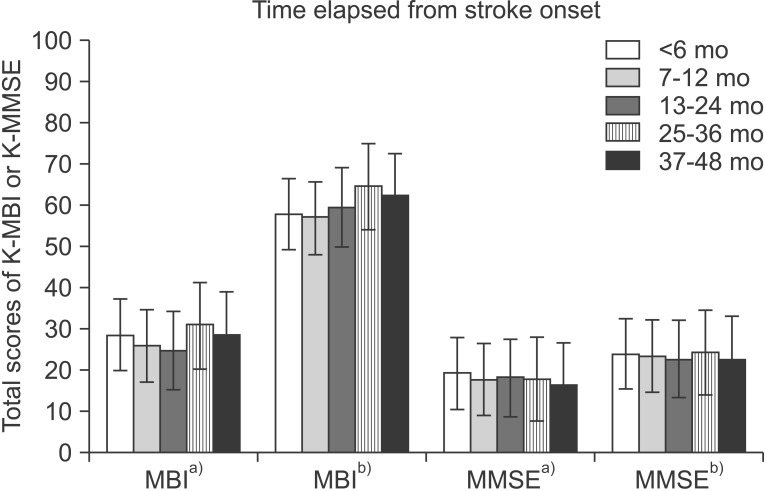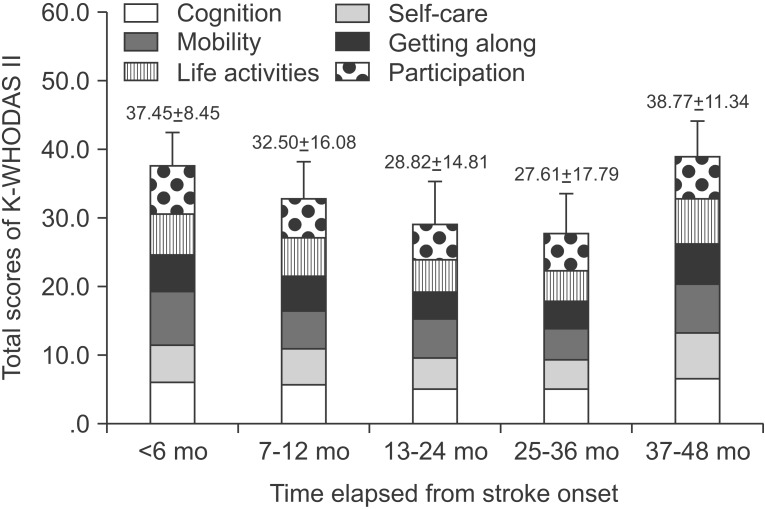Ann Rehabil Med.
2016 Feb;40(1):111-119. 10.5535/arm.2016.40.1.111.
Monitoring of Functioning Status in Subjects With Chronic Stroke in South Korea Using WHODAS II
- Affiliations
-
- 1Department of Physical and Rehabilitation Medicine, Inha University School of Medicine, Incheon, Korea. rmjung@inha.ac.kr
- KMID: 2155173
- DOI: http://doi.org/10.5535/arm.2016.40.1.111
Abstract
OBJECTIVE
To follow up the long-term functioning in a community through assessing personal background and status based on the International Classification of Functioning, Disability and Health (ICF) after a stroke, by using a Korean version of World Health Organization Disability Assessment Scale II (K-WHODAS II).
METHODS
We surveyed 146 patients diagnosed at the first-onset of acute stroke and discharged after Inha University Hospital, and 101 patients answered the K-WHODAS II survey. We analyzed the relationship of six functioning domains of K-WHODAS II with K-MMSE (Korean version of Mini-Mental State Examination) and K-MBI (Korean version of Modified Barthel Index) at admission and discharge, and personal background. All subjects were divided into five groups, according to the disease durations, to assess the functional changes and the differences of K-MMSE and K-MBI at the admission and discharge.
RESULTS
K-MBI and K-MMSE at admission and discharge showed no significant differences in all five groups, respectively (p>0.05), reflecting no baseline disparity for long-term follow-up. All subjects showed positive gains of K-MBI and K-MMSE at discharge (p<0.05). The six functioning domains and total scores of K-WHODAS II had decreasing trends until 3 years after the stroke onset, but rose thereafter. Higher scores of K-MBI and K-MMSE, younger age, women, working status, higher educational level, and living with a partner were correlated with lower scores of K-WHODAS II (p<0.05).
CONCLUSION
The long-term functioning after stroke was affected not only by cognitive and motor status in hospital, but also by certain kinds of personal background. K-WHODAS II may be used to monitor functioning status in a community and to assess personal backgrounds in subjects with chronic stroke.
Keyword
MeSH Terms
Figure
Cited by 1 articles
-
Effect of a Caregiver's Education Program on Stroke Rehabilitation
Sang-Eun Hong, Chang-Hwan Kim, Ee-jin Kim, Kyung-Lim Joa, Tae-Hyun Kim, Sang-Keun Kim, Hee-Jun Han, Eui-Chang Lee, Han-Young Jung
Ann Rehabil Med. 2017;41(1):16-24. doi: 10.5535/arm.2017.41.1.16.
Reference
-
1. Andersen HE, Eriksen K, Brown A, Schultz-Larsen K, Forchhammer BH. Follow-up services for stroke survivors after hospital discharge: a randomized control study. Clin Rehabil. 2002; 16:593–603. PMID: 12392333.2. Dhamoon MS, Moon YP, Paik MC, Boden-Albala B, Rundek T, Sacco RL, et al. Long-term functional recovery after first ischemic stroke: the Northern Manhattan Study. Stroke. 2009; 40:2805–2811. PMID: 19556535.3. Schlote A, Richter M, Wunderlich MT, Poppendick U, Moller C, Schwelm K, et al. WHODAS II with people after stroke and their relatives. Disabil Rehabil. 2009; 31:855–864. PMID: 19093276.
Article4. de Pedro-Cuesta J, Alberquilla A, Virues-Ortega J, Carmona M, Alcalde-Cabero E, Bosca G, et al. ICF disability measured by WHO-DAS II in three community diagnostic groups in Madrid, Spain. Gac Sanit. 2011; 25(Suppl 2):21–28. PMID: 22192450.
Article5. World Health Organization. Measuring health and disability: manual for WHO Disability Assessment Schedule (WHODAS 2.0). Switzerland: World Health Organization;2010.6. Brazier JE, Walters SJ, Nicholl JP, Kohler B. Using the SF-36 and Euroqol on an elderly population. Qual Life Res. 1996; 5:195–204. PMID: 8998488.
Article7. Lee HJ, Kim DJ. Cultural adaptation and reliability testing of Korean version of the World Health Organization Disability Assessment Schedule 2.0: 12-item versions. J Korean Soc Phys Med. 2011; 6:475–488.8. Andrews G, Kemp A, Sunderland M, Von Korff M, Ustun TB. Normative data for the 12 item WHO Disability Assessment Schedule 2.0. PLoS One. 2009; 4:e8343. PMID: 20020047.
Article9. Patel MD, Coshall C, Rudd AG, Wolfe CD. Cognitive impairment after stroke: clinical determinants and its associations with long-term stroke outcomes. J Am Geriatr Soc. 2002; 50:700–706. PMID: 11982671.
Article10. Pettersen R, Dahl T, Wyller TB. Prediction of long-term functional outcome after stroke rehabilitation. Clin Rehabil. 2002; 16:149–159. PMID: 11911513.
Article11. Kelly-Hayes M, Beiser A, Kase CS, Scaramucci A, D'Agostino RB, Wolf PA. The influence of gender and age on disability following ischemic stroke: the Framingham study. J Stroke Cerebrovasc Dis. 2003; 12:119–126. PMID: 17903915.
Article12. Organization for Economic Co-operation and Development. OECD health care quality review: Korea. Paris: Organization for Economic Co-operation and Development;2012.13. Kang BH. The relationship between family support and activities of daily living abilities for the hemiplegic patients (after stroke). Korean J Rehabil Nurs. 2000; 3:5–14.
- Full Text Links
- Actions
-
Cited
- CITED
-
- Close
- Share
- Similar articles
-
- Development of Korean version of World Health Organization Disability Assessment Schedule II (WHODAS II-K) in Community Dwelling Elders
- Functional Status and Related Factors of Disabled Persons Using WHODAS II
- Korean Cultural Adaptation of WHODAS 2.0 (36-Item Version): Reliability and Linking to ICF
- Factors Associated with Physical Functioning among Community-Dwelling Older Adults
- Predictors for Change in Disability in Community-Dwelling Elders




